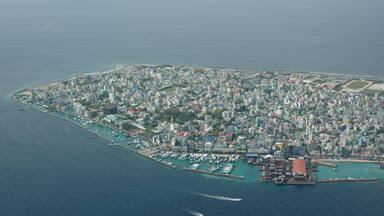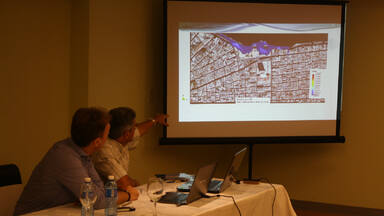Old Havana and its Fortification System
Old Havana and its Fortification System
Havana was founded in 1519 by the Spanish. By the 17th century, it had become one of the Caribbean's main centres for ship-building. Although it is today a sprawling metropolis of 2 million inhabitants, its old centre retains an interesting mix of Baroque and neoclassical monuments, and a homogeneous ensemble of private houses with arcades, balconies, wrought-iron gates and internal courtyards.
Description is available under license CC-BY-SA IGO 3.0
Vieille ville de La Havane et son système de fortifications
Fondée en 1519 par les Espagnols, La Havane est devenue au XVIIe siècle un grand centre de construction navale pour les Caraïbes. Bien qu'elle soit aujourd'hui une métropole tentaculaire de deux millions d'habitants, son centre ancien conserve un mélange intéressant de monuments baroques et néoclassiques, ainsi qu'un ensemble homogène de maisons avec des arcades, des balcons, des grilles en fer forgé et des cours intérieures.
Description is available under license CC-BY-SA IGO 3.0
مدينة هافانا القديمة ونظام الحصون
تأسست هافانا على يد الإسبان عام 1519 واستحالت في القرن السابع عشر مركزاً عملاقاً لبناء السفن في جزر الكاريبي. ومع أنّها أصبحت اليوم مدينةً من مليوني نسمة، إلاّ أنّ وسطها القديم يحافظ على مزيجٍ مهم من المباني ذات الطراز الباروكي والكلاسيكي الجديد، إضافةً إلى مجموعة متجانسة من المنازل بقناطرها وشرفاتها وشبابيكها المصنوعة من الحديد المطروق وساحاتها الداخليّة.
source: UNESCO/CPE
Description is available under license CC-BY-SA IGO 3.0
哈瓦那旧城及其工事体系
哈瓦那由西班牙人于1519年建立,17世纪成了加勒比海主要的造船中心之一。虽然哈瓦那今天是一个有200万人口且不断扩张的都市,但其旧城中心仍保留着引人入胜的巴洛克式和新古典风格混合的建筑物,所有的民房都有拱廊、阳台、铸铁的大门和内院。
source: UNESCO/CPE
Description is available under license CC-BY-SA IGO 3.0
Старая Гавана и ее укрепления
Гавана была основана испанцами в 1519 г.. К XVII в. город стал одним из основных центров судостроения в Карибском регионе. И хотя сегодня Гавана представляет собой расширяющуюся во все стороны метрополию с 2 млн. жителей, ее старый центр сохраняет интересное смешение памятников барокко и классицизма, а также целостные ансамбли частных жилых домов с галереями, балконами, чугунными воротами и внутренними двориками.
source: UNESCO/CPE
Description is available under license CC-BY-SA IGO 3.0
Ciudad vieja de La Habana y su sistema de Fortificaciones
Fundada en 1519 por los españoles, La Habana se convirtió en el siglo XVII en un importante astillero para la región del Caribe. Aunque hoy es una metrópoli tentacular con dos millones de habitantes, su antiguo centro conserva una interesante mezcla de monumentos barrocos y neoclásicos, así como un conjunto homogéneo de casas con arcadas, balcones, rejas de hierro forjado y patios interiores.
source: UNESCO/CPE
Description is available under license CC-BY-SA IGO 3.0
オールド・ハバナとその要塞群
source: NFUAJ
Oud Havana en haar vestingwerken
Havana was de laatste stad die de Spanjaarden – in 1519 – stichten in Cuba. In 1607 werd het de hoofdstad van Cuba en tegen de 17e eeuw was het uitgegroeid tot een van de belangrijkste centra van de Caraïben voor scheepsbouw. De locatie maakte van de stad een perfect verzamelpunt voor de vloot met schatten uit Mexico en Peru op weg naar Spanje. Hoewel Havana tegenwoordig een uitgestrekte metropool van twee miljoen inwoners is, heeft het oude centrum een interessante mix van barokke en neoklassieke monumenten weten te behouden. Het is een homogeen geheel van privéhuizen met arcades, balkons, smeedijzeren poorten en binnenplaatsen.
Source: unesco.nl
Outstanding Universal Value
Brief Synthesis
Founded about 1519 on Cuba’s north-western shore, Old Havana has maintained a remarkable unity of character through its adherence to its original urban layout. Urban plazas surrounded by many buildings of outstanding architectural merit and narrow streets lined with more popular or traditional styles permeate the historic centre of the city. Its overall sense of architectural, historical and environmental continuity makes it the most impressive historical city centre in the Caribbean and one of the most notable in the American continent as a whole. With the establishment and development of the fleet system in the Spanish West Indies, Havana in the second half of the 16th century became the largest port in the region, and in the 18th century developed the most complete dockyard in the New World, both of which necessitated military protection. The extensive network of defensive installations that was created between the 16th and 19thcenturies includes some of the oldest and largest stone fortifications now standing in the Americas.
Old Havana, which is defined by the extent of the former city walls, has maintained the pattern of the early urban setting with its five large plazas, each with its own architectural character: Plaza de Armas, Plaza Vieja, Plaza de San Francisco, Plaza del Cristo and Plaza de la Catedral. Around these plazas are many outstanding buildings, including the Iglesia Catedral de La Habana, Antiguo Convento de San Francisco de Asís, Palacio del Segundo Cabo and Palacio de los Capitanes Generales. Interspersed with this mix of baroque and neoclassical style monuments is a homogeneous ensemble of private houses with arcades, balconies, wrought-iron gates and internal courtyards –many of them evocatively time-worn. The complex system of fortifications that protected Havana, its port and its dockyard is comprised of the Fortaleza de San Carlos de la Cabaña –one of the largest colonial fortresses in the Americas– on the east side of the narrow entrance canal to Havana Bay; Castillo de la Real Fuerza –one of the oldest colonial fortresses in the Americas (begun in 1558)– on the west side of the canal; and Castillo de San Salvador de la Punta and Castillo de los Tres Reyes del Morro guarding the entrance to the canal; as well as the Torreón de San Lázaro, Castillo de Santa Dorotea de Luna de la Chorrera, Reducto de Cojímar, Baluarte del Ángel, Lienzo de la Muralla y Puerta de la Tenaza, Restos de Lienzo de la Muralla, Garita de la Maestranza, Cuerpo de Guardia de la Puerta Nueva, Restos del Baluarte de Paula, Polvorín de San Antonio, Hornabeque de San Diego, Fuerte No. 4, Castillo de Santo Domingo de Atarés, Castillo del Príncipe and Fuerte No. 1.
Criterion (iv)The historic fortunes of Havana were a product of the exceptional function of its bay as an obligatory stop on the maritime route to the New World, which consequently necessitated its military protection. The extensive network of defensive installations created between the 16th and 19th centuries includes some of the oldest and largest extant stone fortifications in the Americas, among them La Cabaña fortress on the east side of the narrow entrance canal to Havana Bay, Real Fuerza Castle on the west side, and Morro castle and La Punta castle guarding the entrance to the canal.
Criterion (v) The historic centre of Havana has maintained a remarkable unity of character resulting from the superimposition of different periods in its history, which has been achieved in a harmonious yet expressive manner through adherence to the original urban layout and underlying pattern of the city as a whole. Within the historical centre of the city are many buildings of outstanding architectural merit, especially surrounding its plazas, which are set off by houses and residential buildings in a more popular or traditional style that, when considered as a whole, provide an overall sense of architectural, historical and environmental continuity that makes Old Havana the most impressive historical city centre in the Caribbean and one of the most notable in the American continent as a whole.
Integrity
Within the boundaries of Old Havana and its Fortifications are located all the elements necessary to express its Outstanding Universal Value, including Old Havana’s urban layout with its five large plazas and its harmonious ensemble of architectural monuments and traditional-style popular buildings from different periods in its history, and its extensive network of fortifications. Because of the historic role played by building ordinances during the 19th and 20th centuries, Old Havana’s urban and architectural morphology has remained virtually unchanged. The city’s 214-ha. historic centre and its fortifications are of sufficient size to adequately ensure the complete representation of the features and processes that convey the property’s significance. Old Havana and its Fortifications does not suffer from adverse effects of development, though much of Old Havana’s built fabric is in disrepair due to decay, chronic neglect and the natural elements.
Authenticity
Old Havana and its Fortifications have a high degree of authenticity in terms of location and setting, forms and designs, and materials and substances. Between the 1950s and the 1970s, certain architectural interventions and changes in use affected Old Havana’s authenticity, but without reducing a clear understanding of the veracity of the ensemble and its attributes. Havana is occasionally subjected to severe tropical weather (including hurricanes, as in 2008), which can threaten the authenticity of the property.
Protection and management requirements
Old Havana and its Fortifications is largely owned by the Cuban state, with some parts owned by private individuals or legal entities. The inscribed property is protected by provisions in the Constitución de la República de Cuba (Constitution of the Republic of Cuba) of 24 February 1976 and by National Monuments Commission Resolution 3/1978 designating the historic urban centre of the old town of San Cristobal de La Habana and the system of colonial fortifications surrounding it as a National Monument, in application of the Ley de Protección al Patrimonio Cultural (Law on the Protection of Cultural Property, Law No. 1 of 4 August 1977), and the Ley de Monumentos Nacionales y Locales (Law on National and Local Monuments, Law No. 2 of 4 August 1977). National Monuments Commission Resolutions 12/1980 and 14/1980 established, respectively, a national working group responsible for the historic centre of Old Havana and its fortifications, and measures to define the limits of the historic centre and to protect its buildings by halting demolition and by planning reinforcement work. The Asamblea Provincial del Poder Popular (Provincial Assembly of People’s Power) is responsible for the administration of the historic centre of Havana. A specialized institution of the Cuban Ministry of Culture provides legal, technical and administrative support for research and formulation of policies and projects for the conservation and rehabilitation of the historic centre. The Cuban state provides resources for a Five-Year Restoration Plan, which began in 1981, and ensures the viability and sustainability of the multi-year Plan by means of an agreement with the Office of the Historian of Havana (an autonomous organization of city government founded in 1938), which manages the process of rehabilitation and restoration.
Sustaining the Outstanding Universal Value of the property over time will require continuing existing programmes and processes, and establishing new initiatives as required, to ensure the proper repair and conservation of the built fabric of Old Havana that is in disrepair due to decay, chronic neglect and the elements; preparing a risk reduction and emergency preparedness plan related to severe weather and other identified or potential threats; and establishing monitoring indicators.


 View photos from OUR PLACE the World Heritage collection
View photos from OUR PLACE the World Heritage collection







